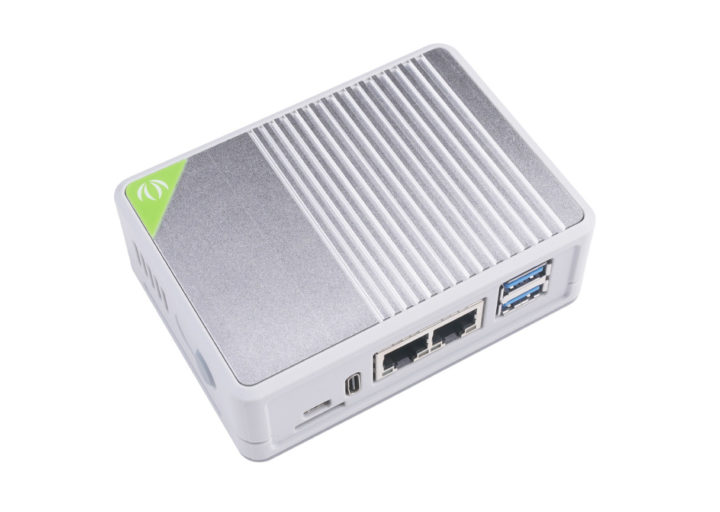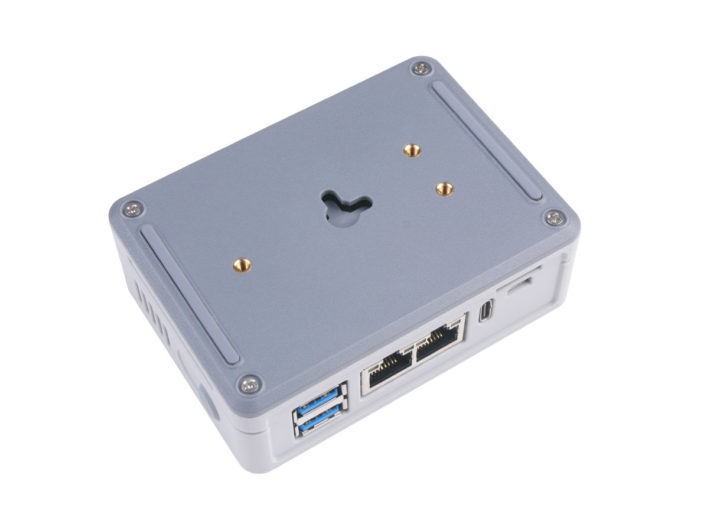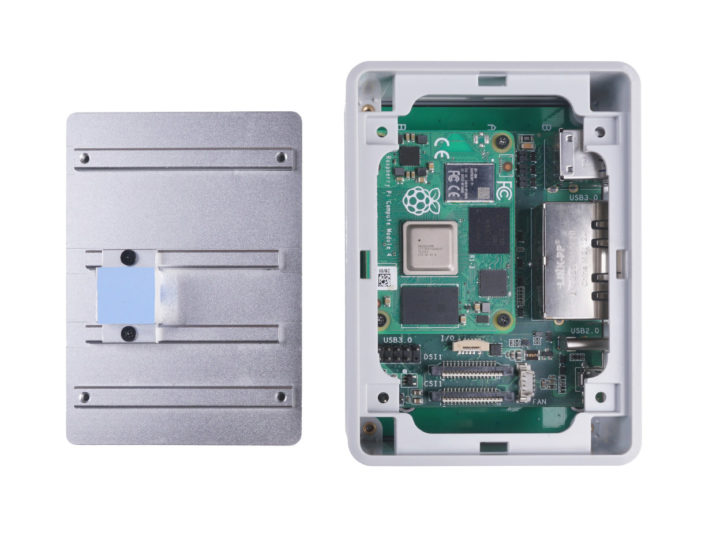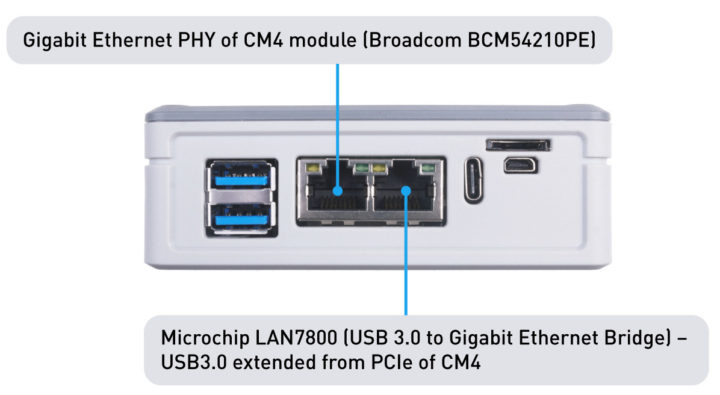There are many hardware platforms based on Raspberry Pi CM4 system-on-module, but in most instances, only the baseboard is provided, and you have to handle mounting and/or make an enclosure by yourself.
One of those boards was Seeed Studio’s “Dual Gigabit Ethernet Carrier Board for Raspberry Pi Compute Module 4”, which as the name implies, offers two Gigabit Ethernet ports, as well as two USB 3.0 ports, and a micro HDMI port for video output. I say “was” because the company has now designed a PC/ABS case with an aluminum alloy cover acting as a heatsink to keep the RPi CM4 module cool.

- SoM – Raspberry Pi CM4 with up to 8GB RAM, 32GB eMMC flash, dual-band WiFi 5 and Bluetooth 5.0 module; replaceable by any Raspberry Pi Compute Module 4
- Storage – MicroSD card slot (only accessible with RPi CM4Lite module)
- Video Output – Micro HDMI 2.0 port up to 4Kp60
- Connectivity – Dual Gigabit Ethernet RJ45 ports with one implemented through Broadcom BCM54210PE PHY and the other through LAN7800 USB 3.1 to Ethernet controller (via PCIe to USB 3.0 bridge)
- USB – 2x USB 3.0 ports
- Misc – Reset button
- Power Supply – 5V/3A via USB-C port
- Dimensions – Carrier board: 75 x 64 x 21mm; enclosure : 101 x 73 x ~32 mm


Although the case is made of plastic, the metal cover could potentially block WiFi/Bluetooth signals to some extent. Note while the specs like WiFi & Bluetooth, the rest of the page only refers to Raspberry Pi CM4 with 4GB RAM and 32GB eMMC flash, and never mentions the wireless module.
Seeed Studio’s mini router includes the carrier board, a Raspberry Pi CM4 (4GB/32GB), the plastic and aluminum case, and a 5V/4A USB Type-C power adapter with US/AU/UK/EU plugs.
You can pre-order all that for $149 plus shipping with expected availability on August 20th. I’m old enough to remember when news about new products were all being about being cheaper, better, and faster. $149 is starting to get on the high side, especially, considering you could get a Rockchip RK3399 powered NanoPi R4S mini router with very similar specifications, including two Gigabit Ethernet ports, two USB 3.0 ports, a metal enclosure, and a 5V/4A power adapter for under $100. I tested it successfully last December with OpenWrt, but software support should have further improved, and there are Armbian images as well for Ubuntu 20.04 and Debian 10. There’s no video output at all however.

Jean-Luc started CNX Software in 2010 as a part-time endeavor, before quitting his job as a software engineering manager, and starting to write daily news, and reviews full time later in 2011.
Support CNX Software! Donate via cryptocurrencies, become a Patron on Patreon, or purchase goods on Amazon or Aliexpress






Not as big a memory but could you just use a USB to Ethernet adaptor on a Khadas, Radxa or HardKernel board ?
> You can pre-order all that for $149 plus shipping
Or you try to order the items individually and ‘assemble’ them on your own saving 20 to 50 bucks. Case is $19, Dual GbE carrier board (using the crappy LAN7800 chip) is $45 and the CM4 thingies range from $25 to $65.
The most funny thing about this product is the placement of both USB host controller and USB Ethernet controller directly beneath the CM4 which results in this: ‘It must be used with a CM4 heat sink. Otherwise it may cause USB or Ethernet instability’.
Is the speed reduction due to USB to Gigabit ethernet problem solved? I think Jeff Geerling have tested this board in comparison to DFRobot’s board. While having spare USB3 ( behind a hub ) is a nice bonus, not running at near gigabit speed in 2021 is not. Aside from R4S, DFRobot boards, PIzza from openembed is also a good candidate ( these are sold but with not so much documents at this time, some tinkering is a must ) having a PLX chip inside, which splits the PCIe gen2x1 to RTL8111, mini pcie, and a M key NVMe slot.
> having spare USB3 ( behind a hub )
There’s no hub but a VL805 USB3 host controller (same thing as on the RPi 4) attached to the Gen2 lane providing four USB3 ports. Trapped between PCB and CM4 the VL805 tends to overheat without additional cooling 🙂
And not only poor performance with those kitchen-sink benchmarks Jeff used is a problem but the LAN7800 suffers from the same other problems RPi 3B+ is plagued with (search RPi forums for RTL8153 – which is a far better USB Ethernet chip – and you’ll find them).
Yeah; even with a few patches from Seeed, the LAN7800 behind the USB 3.0 controller will eat into overhead a bit, especially if you want to get to high pps routing (I could only get up to like 40,000 pps, whereas I could get up to 80,000 on a PCIe-based NIC through to the onboard NIC).
BTW: I think it’s important to always monitor the ‘environment’ when testing network or storage performance especially on a platform where you can’t trust into the 2nd operating system’s mechanisms (Linux’ sysfs having no idea of ThreadX controlling the hardware).
If the SoC overheats ThreadX will throttle down the CPU cores while Linux will still report running at max cpufreq. One of the reasons sbc-bench has an -m switch for monitoring while running other benchmarks in parallel 🙂
This or just adda switch and share the gigabit amongst both ports…
I felt slightly baffled when I read pcie to usb to ethernet, who designs such a crap?
> pcie to usb to ethernet, who designs such a crap?
Seeed Studio. Low throughput + high consumption at the same time 🙂
But I would assume they know their target audience well enough so why bother…
OTOH they might know that Raspberries run ThreadX as main OS and choose as such hardware components (like the LAN7800) that have driver support in the primary OS to provide features like e.g. netboot on both NIC ports (just an assumption).